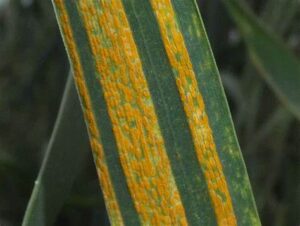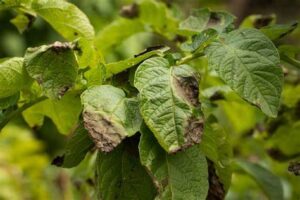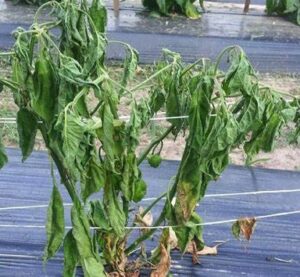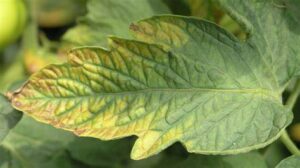CLASSIFICATION OF PLANT DISEASES
First of all, lets understand what are symptoms, sign and syndrome before knowing the classification of disease.
Symptoms: The internal and external alteration or reaction of a plant as a result of any disease is called symptoms.
Sign: Sign refers to presence of pathogen or its any parts or spores/propagules on the plants body.
Syndrome: A set of symptoms which characterize a disease.
Classification of Plant Disease
Based on cause of Disease
- Infectious or Parasitic Disease
The disease caused by a pathogen which can spread from a diseased to a healthy plant. Infectious or Parasitic Disease are caused by fungi, bacteria, viruses, viroid, mollicutes, phytoplasmas and parasitic higher plants.
Examples: Late blight of potato, Black rots of crucifers, tobacco mosaic and peach yellow etc.
Infectious diseases are further classified on the basis of their occurrence:
- Endemic Disease: Such diseases are prevalent in or confined to a particular area. Such diseases are more or less regularly occurs in moderate to severe form in a particular area. The causal agent is well established in the locality due to its ability to survive in the soil or environment from one season to another, g., late blight of potato.
- Epidemic Disease: In case of plants, it is also called as Epiphytotic disease and defined as a disease which occurs widely but periodically covering a large population in severe form. The term Epidemic generally refers to wide spread and severe outbreak of a disease which appear very severely among a large section of population. Such diseases may be constantly present in an area but assumes severe proportions on occasions due to the presence of favorable environment conditions at that time.
Example: potato late blight during 1845 in Ireland. - Sporadic Disease: Such diseases occur at very irregular intervals and locations and in relatively few instances.
- Pandemic Disease: When a disease is prevalent throughout the country or continent or world in a moderate to severe form called as Pandemic disease. It may be endemic in one region and epidemic in another region, g., cereal rusts.
- Non- infectious or Non-parasitic Disease
Such diseases are caused by:
- Due to low or high temperature
- Due to lack of or excess of soil moisture or light
- Due to lack of oxygen, e.g., black heart of potato due to improper oxygen relation in the storage and fields
- Due to Air pollution
- Due to Nutrient deficiencies, e.g., Khaira disease of rice due to Zn deficiency
- Due to Mineral toxicities
- Due to soil acidity or alkalinity
- Due to toxicity of pesticides
- Due to improper cultural practices
- Examples: Black tip of mango caused by Boron deficiency
Based on spread on Plant Body
- Localized Diseases: If any disease affects only one or two parts/organs of plant is called localized disease.
- Systemic Disease: If any disease affects the entire plant body within its system. Here pathogen moves throughout the plant body.
Based on symptoms produced
- Rusts: Gives a rusty appearance to the plant and caused by Uredinales (Rust fungi). The rust appears as relatively small pustules of spores usually breaking through the host epidermis. The pustules may be dusty or compact and red, brown, yellow or black in colour due to spores of fungus.
- Smuts: A disease caused by ustilaginaceae and characterized by masses of dark, powdery spores. Smut means charcoal like powder. In case of white blisters, these appears as white blister like pustules on the leaf and other part of the plants which break the epidermis and expose powdery masses of spores. Blotch is characterized by large and irregular spots or lesions on leaves, shoots and stems.

Wheat Rust - Mildews: A plant disease caused by a fungus in which the mycelium and spores are seen as a whitish/greyish/brownish/purplish growth on the host surface. Two types of mildews occur on plants.
Downey mildew: A plant disease in which the mycelium and spores of the fungus appear as a Downey growth on the host surface. Like Downey feather of birds which stuck tight near to their skin, the fungus also sticks tightly to the leaf surface.
Powdery mildew: Enormous number of spots are formed due to superficial growth of fungus giving the host surface a dusty, ash like appearance. - Blight: A disease characterized by general and rapid killing of leaves, flowers and stems.

Blight - Wilt: Loss of rigidity and dropping of plant parts wholly or partially. The leaves lose their turgidity, become flaccid and droop. Later the young growing tip and the entire plants wilt. Wilt may be due to injury to root, partial plugging of water conducting vessels or due to toxins produced by pathogen and moved to delicate tissues.

wilt - Canker: A necrotic or sunken lesion on a stem, branch or fruit of a plant, e.g., citrus canker caused by Xanthomonas citri.
- Root rot and Fruit rot:
- Leaf spot: The cells are killed in limited areas and dead tissues usually turn brown to black. Mostly chlorosis occurs first followed by necrosis.
Based on perpetuation & survival of pathogen
- Seed borne: Black rust of crucifers.
- Soil borne: Root rot.
- Air borne Disease: Powdery mildew and leaf spots.
Colour change and Plant Disease
The change in colour from normal or say any discolouration is common symptom of plant disease.
Etiolation: Yellowing of plants due to lack of light.
Chlorosis: It refers to yellowing of green tissues due to chlorophyll destruction. It may be due to low temperature, iron deficiency excess of lime or alkali soil and infection caused by viruses, fungi or bacteria.

Chromosis: Change in colour from green to red, purple or orange is called as chromosis.
Albinism: Leaves are devoid of any pigment and look blanched or white.
Hyperplasia and Hypertrophy (Overgrowth)
Excessive growth due to increase in number of cells resulting from excessive cell division at the point of infection in the host tissues is termed as Hyperplasia.
Excessive growth due to increase in size of cells or cell enlargement is called Hypertrophy.
Necrosis: The death of cells or of tissues as a result of parasitic activity of pathogens. It may be due to exposure to highly toxic compounds, severe cold or heat stress etc.
Die Back & Wither Tip
Progressive death of shoots and roots generally starting at the tip.
Exudation and Gummosis: production of gum like material from the plant tissues affected by fungi or bacteria. On drying they form a crust.
Sclerotia: It is a compact, hard mass of dormant fungal mycelium which are dark in colour.
Scorch: Burning of leaf margin as a result of infection or unfavorable environmental condition.
Damping off: Destruction of seedling near the soil surface resulting in thee falling of seedlings on the ground.
Gall: swelling is produced on plant due to infection by certain pathogens.
Mosaic: Symptoms of plant viral disease characterized by intermingled of normal and light green or yellowish colour.
Frequently Asked Questions (FAQ)
The period between inoculation and appearance of the first disease symptom is called?
Incubation period.
Mycoplasma is sensitive to?
Tetracycline.
The structure helps to fungi to survive under adverse conditions?
Chlamydospores and sclerotia.
When floral parts modify into leafy structure by pathogenic infection is called as?
Phyllody.
The disease commonly found in jowar fields?
Grain smut.
Red rot of sugarcane, a fungal disease of which causal organism found in?
Seed (Planting material).
Correct sequence of pathogenesis or disease cycle?
Penetration—- Infection——- colonization——–Exit of pathogen.
What is latent virus?
A virus that does not induce symptoms in its host. Such symptoms are called masked symptoms.
What are heteroecious fungi?
Those who passes different stages of life history in different hosts.
Read more…
PLANT PATHOLOGY- AN OVERVIEW
PEARL MILLET (BAJRA) DISEASE- SYMPTOMS & CONTROL
WHEAT DISEASE- SYMPTOMS & CONTROL
BIOLOGICAL CONTROL-MEANING, TYPES & EFFECTS